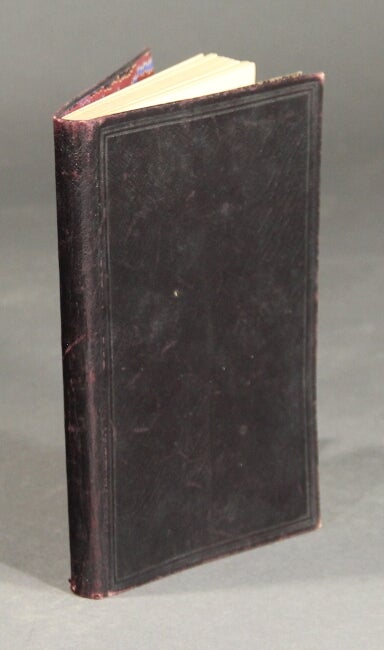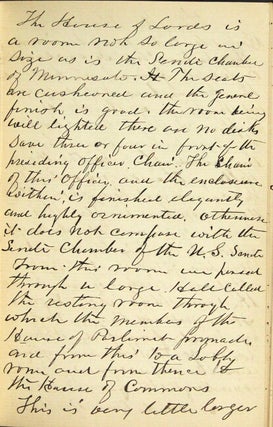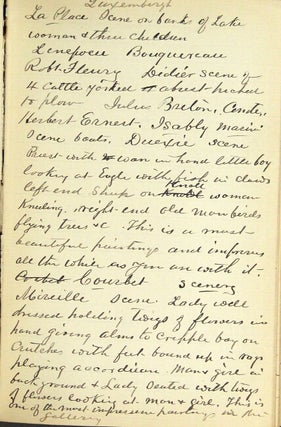Personal journal kept during a European trip
July 9, 1889 to August 23, 1889. 12mo (approx. 7" x 4½"), approx. 130 pages, in ink; legible, and in near fine condition. The journal begins with a London entry: "We arrived from Oxford at 6 o'clock and were driven at once to the Royal Hotel where we had engaged rooms..." This is the journal of a tourist primarily, albeit a famous one, with visits and detailed descriptions of the National Gallery, the British Museum, and other museums where he discourses at length on the artworks, and the Houses of Parliament, where "the Queen's reading room which is rather more finished than the public rooms, generally having a beautiful floor laid of hardwood, polished, and as equally as fine as some floors of this style in the best houses in Minneapolis." At Westminster Abbey, he marvels at the statue of Pitt: "The first monument after entering immediately on the right is that of the immortal Pitt. This is chiselled from white marble and the design is most beautiful and impressive, and as it should hold the place of honor or first-place in the Abby. We perhaps revered the name of Pitt more than that of any other, from the fact of his great influence in behalf of the States during the early struggles for a republican form of government - and for the eloquent defence of the rights of American people and his continued friendship down to the day of his death..." On July 16 Pillsbury notes: "This has been a rather quiet day with myself, Mrs. P., Alfred and Bill in company with Mr. & Mrs. McMillan visited the museums & art gallery at East Kensington while I attended to some business with Morton Rose & Co. and Mr. Sterling of the Trustees Executors & Securities Co. which consumed nearly or quite the forenoon. In the afternoon Mr. McMillan and myself visited the Court Buildings ... We were also admitted to the room where the Parnell trial was in session..." Other visits in London include The Tower of London, the Royal Academy, Academy of Fine Arts, Foundling Hospital, Windsor Castle, Hyde Park, Madam Toussard's Wax Museum. On the 25th of July Pillsbury spent "most of the day in company with W. D. Washburn at Morton Rose & Co. ... with matters connected with Mill Syndicate ... Mr & Mrs. McMillan left this morning for Paris, all expected to accompany them but I was detained by business. We expected to stop overnight at Canterbury as this is a historic city. We finally completed the purchase of Royal Worcester ... and did some other looking about preparatory to leaving for Paris..." By train to Paris, via Dover and Calais. In Paris they visit the Exposition Buildings, including the department of jewels, and precious stones, gold and silver, and displays on Japan, China, and Egypt. Also, the Louvre "Paris is almost under the rule of Roman Catholic religion. There are but few Protestant churches. The Sabbath is not generally observed. The stores retailers are open and business is being done by most all classes." Leaving Paris they visit Fontainbleau and Luxemburg Gardens. Back in Paris they visit the Pantheon, the Museum of Cluney, and the tomb of Napoleon. Later on they take the train to Versailles to which Pillsbury devotes a full 12 pages describing the history, architecture and artworks. On August 9 Pillsbury writes: "Having received a dispatch from W. D. Washburn at Karlsbad in which he requested me to see Mr. Payson regarding the sale of the flour mills. We did not accomplish much in the forenoon. In the afternoon we visited the Louvre before going to the gallery however. We went to Goupes Art Gallery to look at some new paintings which had just arrived..." Pillsbury has a keen eye and writes often in detail of the art, sculpture, and architecture he sees and is comfortable with his mixing pleasure and business interests. He has also visited Brussels and Waterloo, the Hague, Haarlem, and Amsterdam where the journal ends. Pillsbury (1827-1901) was the 8th governor of Minnesota and the co-founder, with his nephew Charles Alfred Pillsbury of the Pillsbury Company. Item #59298
Price: $1,250.00





